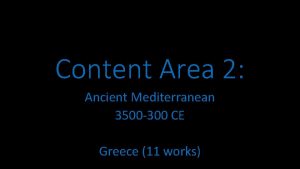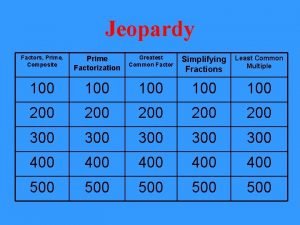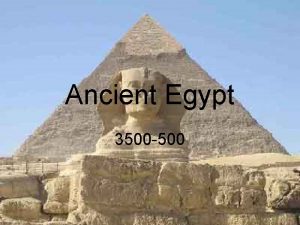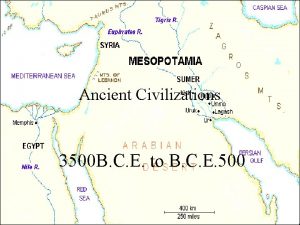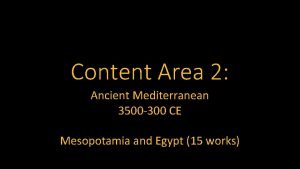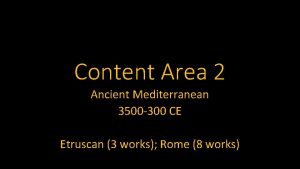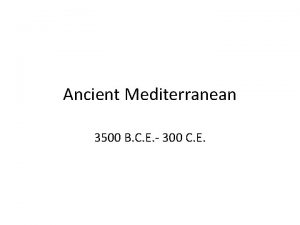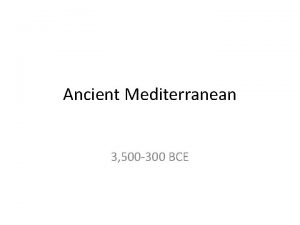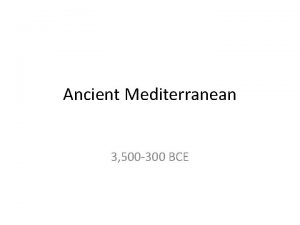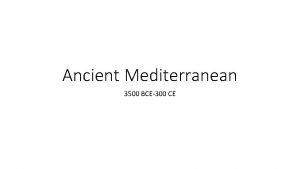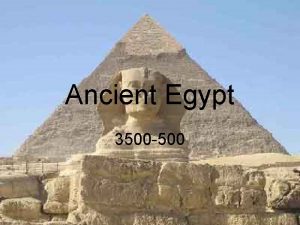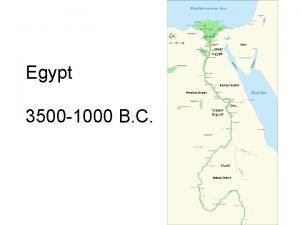Content Area 2 Ancient Mediterranean 3500 300 CE






















- Slides: 22

Content Area 2: Ancient Mediterranean 3500 -300 CE Greece (11 works)

Ancient Greek Art “Man is the measure of all things. ” • 1100 -1025 BCE - Fall of Mycenaean dominance followed by period of disorganization; cultural development, including writing, lost • 9 th and 8 th c. BCE- development of city-state (polis) • 7 th c. BCE- Greeks adopted coinage from Asia Minor and alphabetic writing from the Phoenicians aiding commerce and literature; they traded pots, olive oil, and bronzes for grain and raw materials • 6 th c. BCE- Athens assumes commercial and cultural preeminence with a representative government in which communities had their own magistrates and assemblies where citizens (men) participated and had equal rights to own private property, hold public office, serve in the army or navy and exercise free speech • Greek religion held that creation involved a battle between sky gods and giant earth gods (Titans), the winners living on Mount Olympus

Ancient Greek Art Can be classified into the following categories: Geometric Period ca. 900 -700 B. C. E. Orientalizing Period ca. 725 -600 B. C. E. Archaic Period ca. 625 -480 B. C. E. --- Greeks defeat Persians 480 -479 BCE --- Early Classical Period ca. 480 -450 B. C. E. High Classical Period ca. 450 -400 B. C. E. Late Classical Period ca. 400 -323 B. C. E. Hellenistic Period ca. 323 -30 B. C. E.

Mesopotamian = Worship/ religion; humans or divine rulers interacting with deities; heavily fortified palace complexes and ziggurats with temples- power and authority; historical narrative; conventional approach with registers, combined views, hieratic Egyptian = Afterlife/religion; funerary art-elaborate tombs and temple complexes; permanence; monumental stone architecture; god-kings with absolute power, descended from the sun god; strict, conventional stylizations; hierarchical, composite poses, canon of proportions (except Amarna Period); static stylistically Greek = Humanism; religious and civic architecture and figures with idealized proportions using a canon; societal value of harmony, order, calm restraint (until Hellenistic); glorified exploits of gods and goddesses, heroes/athletes; many primary resources inform us; interest in structure of human body; dynamic changes in styles

The Archaic Period 27. Anavysos Kouros. Archaic Greek. c. 530 B. C. E. Marble with remnants of paint. 6’ 4”H. • Around 530 BC a man named Kroisos died a hero’s death in battle. His grave may have been marked by this figure. • The inscription a base that may belong to this statue read: “stay and mourn at the tomb of dead Kroisos, whom raging Ares destroyed one day as he fought in the foremost ranks” • The “archaic smile” is present, as is the Egyptian stance, but the naturalism of the body far exceeds any figurative sculpture that preceded it. The Greek statues are liberated from the original stone block, where the Egyptian statues were not. This demonstrates the Greek idea of including motion rather than stability. The kouroi are nude and absent of any attributes The flesh was left the natural color of the stone, but the hair, lips, and eyes were painted in encaustic (pigment mixed with hot wax)

18. King Menkaura and queen. Old Kingdom, Fourth Dynasty. c. 2490– 2472 B. C. E. Greywacke. 27. Anavysos Kouros. Archaic Greek. c. 530 B. C. E. Marble with remnants of paint.

The Archaic Period Titled “Peplos Kore” because of the peplos that the figure is wearing. ( a simple, long, woolen belted garment that gives the female figure a columnar appearance. This sculpture was damaged during the sack of the Acropolis in 480 BC by the Persians. This sculpture may have stood as a votive offering in Athena’s sanctuary. Encaustic is visible in places. 28. Peplos Kore from the Acropolis. Archaic Greek. c. 530 B. C. E. Marble, painted details. 4’H.

High Classical or “Golden Age” Period Polykleitos Wrote the treatise “Canon of Polykleitos” – set of mathematical rules or laws for human sculpture 34. Doryphoros (Spear Bearer). Polykleitos. Original 450– 440 B. C. E. Roman copy (marble) of Greek original (bronze). 6’ 11”.

33. Niobides Krater. Anonymous vase painter of Classical Greece known as the Niobid Painter. c. 460– 450 B. C. E. Clay, red -figure technique (white highlights).

used as a market, or for an election, a dramatic performance, a religious procession, military drill, or athletic competition, plus administrative, political, judicial, commercial, social, cultural, and religious activities 26. Athenian agora. Archaic through Hellenistic Greek. 600 B. C. E. – 150 C. E.


35. Acropolis. Athens, Greece. Iktinos and Kallikrates. c. 447– 424 B. C. E. Marble. Parthenon Constructed by order of Pericles to house & honor Athena, 447 -438

Helios and his horses, and Dionysios (Herakles? ), east pediment of the Parthenon. (Birth of Athena) 35. Acropolis. Athens, Greece. Iktinos and Kallikrates. c. 447– 424 B. C. E. Marble.

Plaque of Ergastines 35. Acropolis. Athens, Greece. Iktinos and Kallikrates. c. 447 – 424 B. C. E. Marble.

Temple of Athena Nike 35. Acropolis. Athens, Greece. Iktinos and Kallikrates. c. 447– 424 B. C. E. Marble. Nike means "Victory" in Greek, and Athena was worshiped in this form, as goddess of victory, on the Acropolis. Her temple was the earliest Ionic temple on the Acropolis. Here the citizens worshipped the goddess in hope of a prosperous outcome in the long war fought on land sea against the Spartans and their allies. The Temple of Athena Nike was an expression of Athens' ambition to be the leading Greek city state in the Peloponnese.

Victory adjusting her sandal 35. Acropolis. Athens, Greece. Iktinos and Kallikrates. c. 447 – 424 B. C. E. Marble.

36. Grave stele of Hegeso. Attributed to Kallimachos. c. 410 B. C. E. Marble and paint. 5’ 2”H.

The Hellenistic Period 37. Winged Victory of Samothrace. Hellenistic Greek. c. 190 B. C. E. Marble. The wind sweeps her drapery. Her himation bunches in thick folds around her right leg, and her chiton is pulled tightly across her abdomen and left leg. The statues theatrical effect was amplified by its setting. This sculpture was part of a two-tiered fountain. In the lower basin were large boulders. The fountain’s flowing water created the illusion of rushing waves dashing up against the ship. The sound of splashing water added an to the sense of drama. Art and nature were combined.

The Hellenistic Period Hellenistic sculptors often rendered the common theme of the male athlete in a new way. This boxer is not a victorious young athlete with a perfect face and body, but rather a heavily battered, defeated veteran whose upward gaze may have been directed at the man who had just beaten him. This boxer’s broken nose, distorted face, bleeding wounds and “cauliflower ears” add the sense of realism that the Hellenistic artists sought. 41. Seated boxer. Hellenistic Greek. c. 100 B. C. E. Bronze. HELLENISTIC GREEK

38. Great Altar of Zeus and Athena at Pergamon. Asia Minor (present-day Turkey). Hellenistic Greek. c. 175 B. C. E. Marble (architecture and sculpture). Great Altar of Zeus and Athena at Pergamon 8: 50

38. Great Altar of Zeus and Athena at Pergamon. Asia Minor (presentday Turkey). Hellenistic Greek. c. 175 B. C. E. Marble (architecture and sculpture).

38. Great Altar of Zeus and Athena at Pergamon. Asia Minor (presentday Turkey). Hellenistic Greek. c. 175 B. C. E. Marble (architecture and sculpture).
 3500/300
3500/300 100 + 100 = 200
100 + 100 = 200 Prime factorization of 300,300
Prime factorization of 300,300 100 200 300
100 200 300 200 300 300
200 300 300 200 200 300
200 200 300 300+300+400
300+300+400 300+300+400
300+300+400 300+300+400
300+300+400 300+300+400
300+300+400 400 + 300 + 300
400 + 300 + 300 300 300 400
300 300 400 What the font
What the font 100 200 300
100 200 300 Real content and carrier content in esp
Real content and carrier content in esp Dynamic content vs static content
Dynamic content vs static content Ancient and modern communication
Ancient and modern communication Ancient india vs ancient china
Ancient india vs ancient china Bosch tronic heat
Bosch tronic heat 3500+500
3500+500 3500bce
3500bce The wheel 3500 bc
The wheel 3500 bc Philips lbb 3500
Philips lbb 3500
